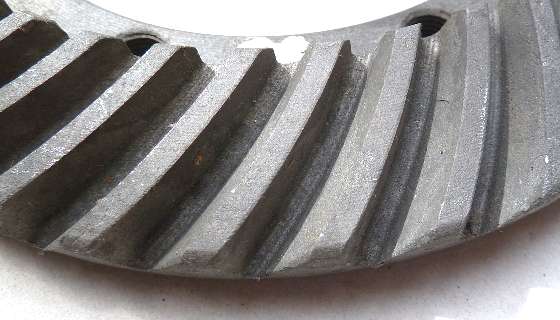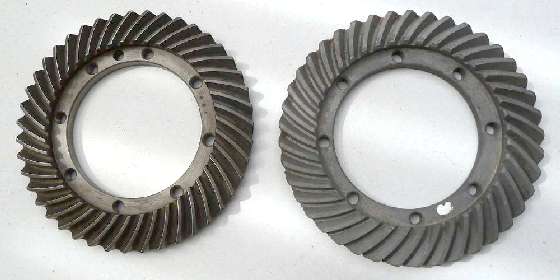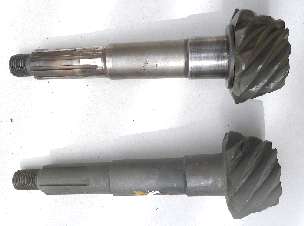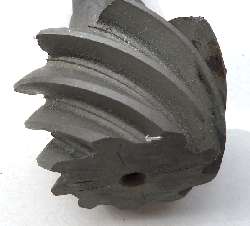The MGA With An Attitude
New RING AND PINION GEARS - RA-202B
These appear to be good parts, so this article is posted just to assure people that there is nothing wrong with the appearance of the parts as received, and for explanation why the gears have this appearance. There are also a few follow up notes on non-standard splines and threads that may require a change of mating parts. Click for larger images.

New ring gear teeth close up.

Above, original ring gear on left, new ring gear on right.
Below left, original pinion gear over new pinion gear.
Below right, new pinion gear close up.


The new 4.55:1 ratio ring and pinion gear set was purchased from Moss Motors by Mike Ellsmore in Victoria, Australia. This particular part has 6 splines on the input end rather than 10, so it requires a change of the differential input flange. It also has metric thread which requires a change of the input flange retaining nut. Mike also had initial adverse reaction to appearance of the new gear teeth, thinking they looked rough when he was expecting a polished finish. This started some discussion on the BBS about the appearance and quality of the parts.
The explanation for appearance is that the parts have been surface treated, as "Parkerizing". The material on the surface may be zinc or manganese phosphate coating that will serve as extreme pressure lubricant during the break in period. Do not remove the coating. More on this later.
There are other processes for surface hardening which may or may not be used before Parkerizing.
Induction hardening is a process in which the surface is heated by a high frequency alternating magnetic field that generates heat in the surface quickly before being quenched. The depth of this hardening is around 0.060 to 0.080. Uneven heating and cooling could create stress within the part. Advantage is depth of hardening and cheap/quick processing.
Tuftriding will immerse the part in hot cyanide compounds, creating a tough, resistant surface that improves fatigue resistance. The hard layer is usually very shallow, only penetrating around 0.005-inch.
Nitriding is a chemical process in which the part is heated in a furnace, air is vacuumed out (remove oxygen), and nitrogen is introduced which penetrates the surface. Depth of hardness is dependent upon the time the part is exposed to the gas. Typically, a nitrided part will have a hardness depth of about 0.010 to 0.030 inch. Nitriding is a low heat process compared to Tuftriding, but it shares the advantage of avoiding the introduction of localized stress zones as in induction hardening.
Parkerizing is a coating process done in a chemically balanced hot phosphoric acid solution via an autocatalytic reaction. The coating material is slightly ingrained into the surface for strong bonding as well as being added onto the surface. The term Parkerizing was originally a trade name, but has since become a generic term for the phosphate coating process (which may be slightly different from various sources).
Another process called Parkoluberising (a trade name) eats its way into the metal so when oil is added it soaks in. This way the oil is not just on the surface of the gear but also impregnated into it. This is not a hardening or coating process, and it leaves a smooth finish when oiled.
On 3/16/2012, Mike Ellsmore wrote:
"My differential specialist (Victorian Differentials and Transmissions - in business since 1983) has assembled the diff with the Moss gears. Has found it impossible to set up gears to run smoothly. Says the gear set has not been lapped together. Says diff would be extremely noisy if used. It is very rough when turned over by hand on the bench. Has told me he wont put his name to the assembly and has recommended I return gears to Moss. To me the teeth look awful rough with this coating and you can see tool marks on the teeth - not like normal gears that are polished almost to a chrome plated finish. So far I haven't heard of anyone on the BBS who has actually used these Moss gears".
I can't say much about the quality of the parts without a personal scratch and sniff. However, gear teeth should look smooth before and after Parkerizing. There should certainly not be anything that looks like machining marks on the working faces of the teeth. I know this is all a pain. You are doing Moss a service by field testing their parts. Too bad the parts had to go half way around the world for the process. Your experienced mechanic's opinion is perhaps as good as it gets. Call Moss and see what they have to say (again). If no satisfaction, return the parts.
|



